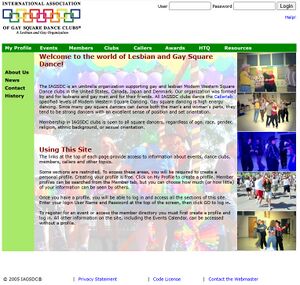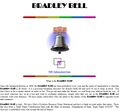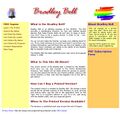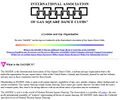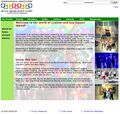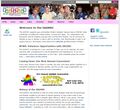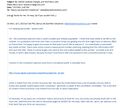A History of Bradley Bell and IAGSDC Websites
Bradley Bell and the IAGSDC websites[1]
By Danny Lee
I have been the Bradley Bell webmaster since 2003, and was the IAGSDC.org webmaster from 2004 to 2014. I felt it was time to record a little of the history of these sites over the years.
Bradley Bell
Initially the Bradley Bell was a printed publication. It provided a simple directory of names and contact information for square dancer subscribers. Using the directory, dancers were able to link up with others when traveling. The Bradley Bell was advertised in terms of "You make the friends, we keep the address book". Later, it added the first lists of Honky Tonk Queens and Golden Boot awards, along with a list of clubs, still as a paper publication. (Subsequently, it became available in a CD version).
The original bradleybell.org website was launched in 2002, and was a simple one page site providing a description of the printed directory, and a down-loadable registration form for new/renewing membership. Gordon Macaw was the Stepmom for both the Bradley Bell directory and the website. Figure 1 shows the original page; figure 2 shows the downloadable member-ship form.
In 2003, I was asked to create an interactive version of the website. Rather than simply being a one page advertisement for the paper publication, the new site allowed subscribers to create and edit an online profile, and included lists of clubs and callers. Information about the printed version was still available, and the PDF version of the registration form was included. I donated all coding for the site to Bradley Bell and the site was released under a GNU license. Figure 3 shows the original home page of the new site.
Paramount to acceptance of the Bradley Bell online format was privacy. Many dancers did not want to be identified publicly, so the web design ensured only the information each member wanted to share was viewable.
This member-driven site would eventually form the core of the new IAGSDC.org website.
IAGSDC.org
The IAGSDC.org website changed very little from its early design in 1998 (figure 4) to 2004. The site was a simple one-page document that provided information about square dance resources and IAGSDC member clubs. Only the webmaster could edit or add content, making it harder to update and grow.
At the 2004 IAGSDC convention in Phoenix, the then IAGSDC Chair John McKinstry asked if I would take over the maintenance of the website. He wanted me to bring the same functionality that I had built for Bradley Bell to the IAGSDC.org web page. I agreed, and by April 2005, I launched a new interactive IAGSDC.org site, shown in figure 5.
The new site was roles-based, which means members could be assigned specific tasks that allowed them to change content in different sections of the website. Distributing responsibilities in this way meant that updated and new content could easily be added to the site. Those with approved editorial access were termed StepMoms, following an IAGSDC tradition. The first two appointed Stepmoms were Andy Shore, who took over maintenance of the Golden Boot section, and Dennis Gomez, who took over responsibility for the Honky Tonk Queen (HTQ) section. A typical HTQ entry is shown in figure 6.
The site also allowed dancers to create their own profile and publish whatever they were comfortable sharing. That included contact information, and a list of their club memberships. It allowed them to track the conventions and other events they had attended. They could record their medallion awards as part of their profile.
As with the Bradley Bell site, privacy was key. Many dancers were uncomfortable being open about their membership of the IAGSDC. It was decided that clubs would not be able to maintain a club membership list online themselves, since that would have meant adding details on behalf of individuals; members could instead opt in to a listing of their memberships in one or more clubs, or withhold that information.
Each club was invited to appoint a club member who could enter and update details of their clubs, including dance locations, days and levels danced, and club callers.
The caller section recorded callers by name, location, and dance level. Importantly, it also included whether they were members of the [[[Gay Callers Association]], which at that time meant that they were also out members of the LGBTQ+ community.
There was considerable debate about whether all members could create events in the event calendar. Some felt it better to keep that a job for an IAGSDC officer; but in the end it was decided that anyone could create an event. A Stepmom could remove any inappropriate content.
I created a registration system that covered fly-ins, A&C weekends, and annual conventions. The system included sections to allow for registration, meal selection, booking of tours (fun badge etc) and attendee information, including allergies etc. PayPal payments through this registration system were supported. The system also tracked payments, refunds, and generated management reports. Subsequently, thousands of registrations for conventions, A&C weekends, and flyins were processed and tracked through the system, saving time and duplicated efforts across those clubs and event committees.
Two further sub-systems were added over time, but were subsequently retired. The first was a housing section, which allowed fly-in organizers to accept requests for local housing and match those requests to local club members who offered a spare room for attendees. While it worked, the many different requirements (only room with someone of the same sex, no smokers, allergies to pets etc) made it somewhat unworkable, and the sub-system was retired after a few years.
The other subsystem was a merchandizing area that allowed clubs and events to sell T-shirts, mugs and other items. The subsystem was added at a time when on-demand marketing sites like CafePress were just starting up. It soon became easier to use those third party dedicated systems and simply link from the event to the merchandizing site, so the mechandizing portion of the IAGSDC site was retired.
The look of the site changed several times over the years. By 2014, a new 'mobile' version formatted for smart phones and tablets had been added alongside the general site, and rather than display social media content on the site itself, there were links to the various social media platforms. Figure 7 shows the IAGSDC home page in 2014.
Ten Years IAGSDC, Bulletin Board, Social Media
In 2009, when the book Ten Years IAGSDC was digitized by Allan Hurst, it was initially made available as a PDF file on the IAGSDC.org site, downloadable from the home page. At that time the site was also adding social media content from Twitter, and a Bulletin Board System (Dish) that encouraged members to chat. See figure 8 for a section of the front page from 2009. When the History Wiki was launched, the Ten Years IAGSDC file was moved to that site.
Because of inherent vulnerabilities in BBS systems, Dish was a short-lived effort. Clubs were rapidly adopting social media for membership communication outside of the IAGSDC website, so IAGSDC support for social media was reduced to announcements from the Executive Board.
Convention Planners
The earliest known attempt at creating a Convention Planners' Handbook was in 1992, after the Albuquerque convention. The convention team put together extensive notes that were passed on to subsequent event planners. However, it is not clear what happened to that document after the following convention.
Around 1997, Randy Clarke and two others started compiling a new "Convention Planners' Handbook". Randy Clarke subsequently passed on this version to the History Wiki team.
In 2008, John McKinstry asked me for help in coordinating a new online Convention Planners' Handbook, and I developed a secure subsection of the IAGSDC site to hold that information. This section could only be accessed by members given permission by a member of the Executive Board. This restriction addressed concerns that proprietary information should not be made available to anyone that was not directly involved in planning a convention. In particular it was considered important that the files and notes in the handbook should NOT be accessed by hotels and other vendors. The teams from each previous convention were encouraged to upload copies of documents related to their own event planning. The content covered contracts for flooring, hotels, meal services, caller selection and contracts and so on. The Convention Planners' section was the last subsystem I programmed for the site.
Divergence: IAGSDC website and History Project
With the advent of the History project, Allan Hurst and I agreed on a division of content across the sites. The Honky Tonk Queen and Golden Boot sections migrated to the history wiki site. The club, member and event registration system stayed on the main IAGSDC site. There was some discussion about whether to relocate the extensive Convention Planners section from the main site to the wiki, because it straddled two worlds. Clearly the documents were historical, but they were also useful tools for future convention planning. In the end, because there was no effective way to secure content in the wiki to a small team rather than making it completely public, the Executive Board decision was to retain the convention planners' section on the IAGSDC.org website. That meant that internal documents about how to negotiate with hotels, vendors and other issues could be stored and access limited to only those members involved in event planning.
Figure 9 shows part of the email discussion about the future of the Convention Planners' section of the site.
The IAGSDC.com Site
The IAGSDC always provided basic hosting for club websites as a subsection of the IAGSDC.org website. The website features permitted were limited because the club sites had to share space with the main site, and there were concerns about potential security breaches accidentally being introduced by member clubs. In about 2012 I created a separate service using IAGSDC.com, to provide free hosting to clubs. Mark Stein took over from me as webmaster for that domain and for liaising with all clubs hosting their sites on the IAGSDC site. I continued as webmaster for the IAGSDC.org site.
Retirement
In 2014, at the Salt Lake City convention, I officially announced my retirement from the position of volunteer webmaster for IAGSDC. Over the decade that I worked on the project, I provided thousands of hours in programming and website operations, vendor management, and in general support for clubs, conventions, and event planners. It was quite a ride and (mostly) fun!
I remain the webmaster for other square dance related sites, including the Bradley Bell, the Boots in Squares club, and the 2029 convention. Somewhere along the way I also created the Convention websites for Salt Lake City (2014) and Palm Springs (2017).
The current IAGSDC webmaster is Fred Loehr.
Photos
Documents
Sources
- ↑ Email, 13 Jul 2025
